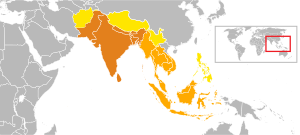| Revision as of 00:17, 2 August 2006 edit88.109.221.226 (talk)No edit summary← Previous edit | Revision as of 10:34, 2 August 2006 edit undoBhadani (talk | contribs)204,742 editsm Reverted edits by 88.109.221.226 (talk) to last version by ValentinianNext edit → | ||
| Line 52: | Line 52: | ||
| ] | ] | ||
| ] | ] | ||
| Links: | |||
Revision as of 10:34, 2 August 2006
Undivided India has several socio-political, historical, and geographical meanings.
Raj
Main article: British RajOfficially, it is a term which refers to the major part of the South Asia which comprised the British Raj, and included the current sovereign states of India, Bangladesh, and Pakistan. Undivided India did not include all geographical regions and nations of the South Asia like Nepal and Bhutan, but included most of the Princely states of India.
References to undivided India are found in some legal enactments including India’s Citizenship Act, 1955, which states that for the meaning of undivided India (in the context of this Act), the undivided India means India as defined in the Government of India Act 1935, as originally enacted. There are innumerable other references to undivided India, in a variety of contexts, but mostly indicating India with boundaries as it existed just before the partition of India into India and Pakistan.
Indies
Main article: Indies
The Indies or East Indies (or East India) is a term used to describe lands of South and Southeast Asia, occupying all of the former British India, the present Indian Union, Pakistan, Bangladesh, Myanmar, Sri Lanka, the Maldives, and also Thailand, Malaysia and Indonesia, which was last called the Dutch East Indies before independence.
The East Indies also include Iranian Baluchistan, Indochina, the Philippine Islands, Brunei, Singapore and East Timor. It does not, however, include Irian Jaya (West Papua), which is part of Melanesia.
The inhabitants of the East Indies are often called East Indians, distinguishing them both from inhabitants of the Caribbean which is also called the West Indies, and from the indigenous peoples of the Americas who are often called "Indians" or "American Indians."
Greater India
Main article: Greater India
Greater India is another term sometimes used to describe the region between Central Asia in the North and tropical Indonesia in the South, and from the borderlands of Persia to Tibet and western China, which has had a significant Indian influence on its culture and civilizaton, including religious thought, language, art and literature.
This socio-cultural region is now part of the modern nations of (from the west): Iran (Seistan-Balochistan province), Pakistan, Afghanistan, India, Nepal, Bhutan, the trans-Tsangpo and Yunnan regions of China, Sri Lanka, Bangladesh, Myanmar, Maldives, Laos, Cambodia, Thailand, Brunei, East Timor, the Philippines, Malaysia, Indonesia and Singapore, the Mauritius, Maldives, Seychelles, Comoros and other islands of the Indian Ocean.
Indosphere
Main article: IndosphereIndosphere is a term, defined as "a socio-political sphere subsuming those countries, cultures, and languages that have historically come under influence from the politics, culture, religion, and languages of India (notably, Laos, Thailand, Cambodia, Burma)."
Akhanda Bharatam
Akhanda Bharatam (literally "undivided India") is the historic homeland of the Hindus, before Islamic conquest and colonial partition, which resulted in the subsequent conversion of a significant number to Islam and Christianity. It includes all of present day Afghanistan, Bangladesh, Bhutan, India, Nepal, Myanmar, Pakistan, Sri Lanka, and Tibet.
The geographic frontiers of this region range from the Himalayan region in the north to the ocean in the south. This is derived from the Vishnu puranam text of India.
- Uttaram yad samudrasya himadreschaiva dakshinam
- varsham tad Bharatam naama Bharati yatra santati
Akhanda Bharatam is the Sanskrit name for this region. Hinduism and Buddhism are the predominant religions. The Indonesia-Malaysia region, the Pakistan-Afghanistan region and the Sistan-Balochistan region later were converted to Islam.
Akhand Bharat is largely based on the concepts of religious or ethnic nationalism rather than a political state. It is an important part of the irredentist ideology of Hindutva subscribed to by Hindu nationalist organizations such as Rashtriya Swayamsevak Sangh (RSS) and political parties such as the Bharatiya Janata Party (BJP).